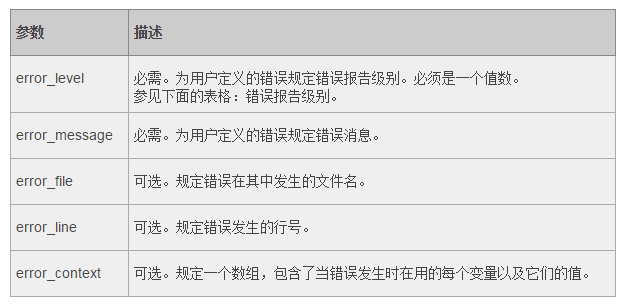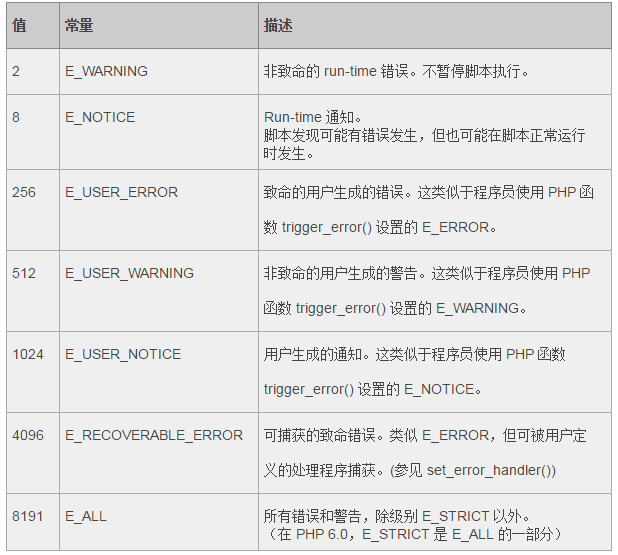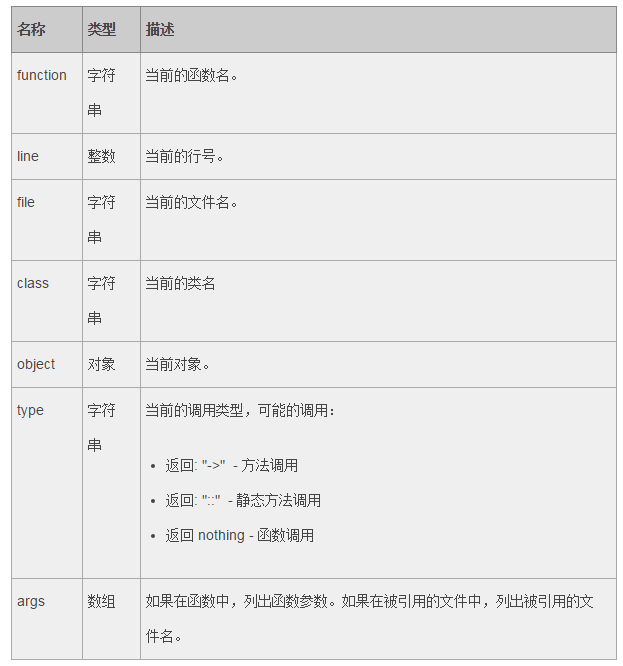PHP error handling experience sharing
This tutorial covers some of the most important error detection methods in PHP.
We will explain you different error handling methods:
Simple "die()" statement
Custom errors and error triggers
Error reporting
Basic error handling: using the die() function
First example Shows a simple script to open a text file:
Copy code The code is as follows:
$file=fopen("welcome.txt","r");
?>
If the file does not exist, you You will get errors like this:
Warning: fopen(welcome.txt) [function.fopen]: failed to open stream:
No such file or directory in C:webfoldertest.php on line 2 In order to avoid users getting errors like the above Error message, we check whether the file exists before accessing it:
Copy code The code is as follows:
if(!file_exists("welcome.txt"))
{
die("File not found");
}
else
{
$file=fopen("welcome.txt","r");
}
?>
Now, if the file does not exist, you will get an error message like this:
File not found The above code is more efficient than the previous code because it uses a simple error handling mechanism to terminate the script after the error.
However, simply terminating the script is not always the appropriate approach. Let's examine alternative PHP functions for handling errors.
Create a custom error handler
Creating a custom error handler is very simple. We simply created a dedicated function that can be called when an error occurs in PHP.
The function must be able to handle at least two parameters (error level and error message), but can accept up to five parameters (optional: file, line-number and error context):
Syntax
error_function(error_level, error_message,
error_file,error_line,error_context)

Error reporting levels
These error reporting levels are the different types of errors that error handlers are designed to handle:

Now, let’s create a function that handles errors:
Copy code The code is as follows:
function customError($errno, $errstr)
{
echo "Error: [$errno] $errstr< ;br />";
echo "Ending Script";
die();
}
The above code is a simple error handling function. When it is triggered, it gets the error level and error message. It then prints the error level and message, and terminates the script.
Now that we have created an error handling function, we need to determine when to trigger the function.
Set Error Handler
PHP’s default error handler is the built-in error handler. We are going to transform the above function into the default error handler when the script is running.
The error handler can be modified so that it only applies to certain errors, so that the script can handle different errors in different ways. However, in this case, we are going to use our custom error handler for all errors:
set_error_handler("customError"); Since we want our custom function to handle all errors, only one set_error_handler() is needed Parameter, you can add a second parameter to specify the error level.
Example
Test this error handler by trying to output a variable that does not exist:
Copy code The code is as follows:
//error handler function
function customError($errno, $errstr)
{
echo "Error: [$errno] $errstr";
}
//set error handler
set_error_handler("customError");
//trigger error
echo($test);
?>
The output of the above code should be similar to this:
Error: [8] Undefined variable: test triggers an error
In the script where the user inputs data, it is useful to trigger an error when the user's input is invalid. In PHP, this task is accomplished by trigger_error().
Example
In this example, if the "test" variable is greater than "1", an error will occur:
Copy code The code is as follows:
$test=2;
if ($test>1)
{
trigger_error("Value must be 1 or below");
}
?>
The output of the above code should be similar to this:
Notice: Value must be 1 or below
in C:webfoldertest.php on line 6 You can trigger an error anywhere in the script, and by adding a second parameter, you can specify the error level that is triggered.
Possible error types:
E_USER_ERROR - Fatal user-generated run-time error. The error cannot be recovered. Script execution was interrupted.
E_USER_WARNING - Non-fatal user-generated run-time warning. Script execution is not interrupted.
E_USER_NOTICE - Default. User-generated run-time notifications. The script found a possible error, which may have occurred while the script was running normally.
Example
In this example, if the "test" variable is greater than "1", the E_USER_WARNING error occurs. If E_USER_WARNING occurs, we will use our custom error handler and end the script:
Copy code The code is as follows:
//error handler function
function customError($errno, $errstr)
{
echo "Error: [$errno] $errstr
";
echo "Ending Script";
die();
}
//set error handler
set_error_handler(" customError",E_USER_WARNING);
//trigger error
$test=2;
if ($test>1)
{
trigger_error("Value must be 1 or below",E_USER_WARNING);
}
?>
The output of the above code should look like this:
Error: [512] Value must be 1 or below
Ending Script Now that we have learned how to create our own errors and how to punish them, let’s study error logging.
Error Logging
By default, according to the error_log configuration in php.ini, PHP sends error records to the server's error logging system or file. By using the error_log() function, you can send error records to a specified file or remote destination.
Sending an error message to yourself via email is a great way to get notified of a specified error.
Send error message via Email
In the example below, if a specific error occurs, we will send an email with an error message and end the script:
Copy code The code is as follows:
/ /error handler function
function customError($errno, $errstr)
{
echo "Error: [$errno] $errstr
";
echo "Webmaster has been notified";
error_log("Error: [$errno] $errstr" ,1,
"someone@example.com","From: webmaster@example.com");
}
//set error handler
set_error_handler("customError",E_USER_WARNING);
//trigger error
$test =2;
if ($test>1)
{
trigger_error("Value must be 1 or below",E_USER_WARNING);
}
?>
The output of the above code should be similar to this:
Error: [512 ] Value must be 1 or below
Webmaster has been notified The email received from the above code is similar to this:
Error: [512] Value must be 1 or below This method is not suitable for all errors. General errors should be logged on the server using the default PHP logging system.
Error backtrace
Definition and usage
PHP debug_backtrace() function generates a backtrace.
This function returns an associative array. The following are the elements that may be returned:

Syntax
debug_backtrace() example
Copy code The code is as follows:
function one($str1, $str2)
{
two("Glenn", "Quagmire ");
}
function two($str1, $str2)
{
three("Cleveland", "Brown");
}
function three($str1, $str2)
{
print_r(debug_backtrace()) ;
}
one("Peter", "Griffin");
?>
Output:
Array
(
[0] => Array
(
[file] => C:webfoldertest. php
[line] => 7
[function] => three
[args] => ] => Array
(
[file] => C:webfoldertest.php
[line] => 3
[function] => two
[args] => > Glenn
[1] => Quagmire
)
)
[2] => Array
(
[file] => C:webfoldertest.php
[line] => 14
[function] = > one
[args] => Array
(
[0] => Peter
[1] => Griffin
)
)
)

Hot AI Tools

Undresser.AI Undress
AI-powered app for creating realistic nude photos

AI Clothes Remover
Online AI tool for removing clothes from photos.

Undress AI Tool
Undress images for free

Clothoff.io
AI clothes remover

AI Hentai Generator
Generate AI Hentai for free.

Hot Article

Hot Tools

Notepad++7.3.1
Easy-to-use and free code editor

SublimeText3 Chinese version
Chinese version, very easy to use

Zend Studio 13.0.1
Powerful PHP integrated development environment

Dreamweaver CS6
Visual web development tools

SublimeText3 Mac version
God-level code editing software (SublimeText3)

Hot Topics
 Working with Flash Session Data in Laravel
Mar 12, 2025 pm 05:08 PM
Working with Flash Session Data in Laravel
Mar 12, 2025 pm 05:08 PM
Laravel simplifies handling temporary session data using its intuitive flash methods. This is perfect for displaying brief messages, alerts, or notifications within your application. Data persists only for the subsequent request by default: $request-
 cURL in PHP: How to Use the PHP cURL Extension in REST APIs
Mar 14, 2025 am 11:42 AM
cURL in PHP: How to Use the PHP cURL Extension in REST APIs
Mar 14, 2025 am 11:42 AM
The PHP Client URL (cURL) extension is a powerful tool for developers, enabling seamless interaction with remote servers and REST APIs. By leveraging libcurl, a well-respected multi-protocol file transfer library, PHP cURL facilitates efficient execution of various network protocols, including HTTP, HTTPS, and FTP. This extension offers granular control over HTTP requests, supports multiple concurrent operations, and provides built-in security features.
 Build a React App With a Laravel Back End: Part 2, React
Mar 04, 2025 am 09:33 AM
Build a React App With a Laravel Back End: Part 2, React
Mar 04, 2025 am 09:33 AM
This is the second and final part of the series on building a React application with a Laravel back-end. In the first part of the series, we created a RESTful API using Laravel for a basic product-listing application. In this tutorial, we will be dev
 Simplified HTTP Response Mocking in Laravel Tests
Mar 12, 2025 pm 05:09 PM
Simplified HTTP Response Mocking in Laravel Tests
Mar 12, 2025 pm 05:09 PM
Laravel provides concise HTTP response simulation syntax, simplifying HTTP interaction testing. This approach significantly reduces code redundancy while making your test simulation more intuitive. The basic implementation provides a variety of response type shortcuts: use Illuminate\Support\Facades\Http; Http::fake([ 'google.com' => 'Hello World', 'github.com' => ['foo' => 'bar'], 'forge.laravel.com' =>
 12 Best PHP Chat Scripts on CodeCanyon
Mar 13, 2025 pm 12:08 PM
12 Best PHP Chat Scripts on CodeCanyon
Mar 13, 2025 pm 12:08 PM
Do you want to provide real-time, instant solutions to your customers' most pressing problems? Live chat lets you have real-time conversations with customers and resolve their problems instantly. It allows you to provide faster service to your custom
 Notifications in Laravel
Mar 04, 2025 am 09:22 AM
Notifications in Laravel
Mar 04, 2025 am 09:22 AM
In this article, we're going to explore the notification system in the Laravel web framework. The notification system in Laravel allows you to send notifications to users over different channels. Today, we'll discuss how you can send notifications ov
 Explain the concept of late static binding in PHP.
Mar 21, 2025 pm 01:33 PM
Explain the concept of late static binding in PHP.
Mar 21, 2025 pm 01:33 PM
Article discusses late static binding (LSB) in PHP, introduced in PHP 5.3, allowing runtime resolution of static method calls for more flexible inheritance.Main issue: LSB vs. traditional polymorphism; LSB's practical applications and potential perfo
 PHP Logging: Best Practices for PHP Log Analysis
Mar 10, 2025 pm 02:32 PM
PHP Logging: Best Practices for PHP Log Analysis
Mar 10, 2025 pm 02:32 PM
PHP logging is essential for monitoring and debugging web applications, as well as capturing critical events, errors, and runtime behavior. It provides valuable insights into system performance, helps identify issues, and supports faster troubleshoot






